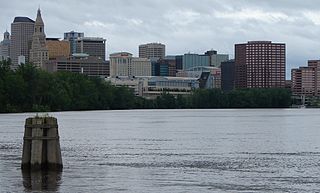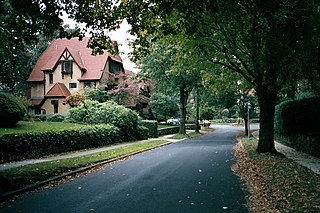Watkinson School is a private co-educational independent day school in Hartford, Connecticut, USA. Watkinson is situated on Bloomfield Avenue adjacent to the University of Hartford. It serves students from 6th through 12th grade. Watkinson also offers a postgraduate option, called The Academy at Watkinson, which allows students who have just graduated from high school to spend an additional year taking courses at Watkinson as well as the University of Hartford. Watkinson is the oldest independent school located within the city limits of Hartford.

The Institute of Pennsylvania Hospital, also known as Kirkbride's Hospital or the Pennsylvania Hospital for Mental and Nervous Diseases, was a psychiatric hospital located at 48th and Haverford Streets in Philadelphia, Pennsylvania, USA. It operated from its founding in 1841 until 1997. The remaining building, now called the Kirkbride Center is now part of the Blackwell Human Services Campus.
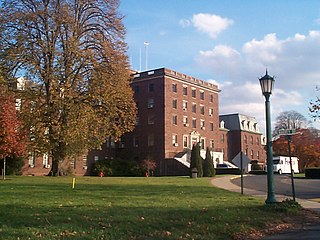
Connecticut Valley Hospital in Middletown, Connecticut is a public hospital operated by the state of Connecticut to treat people with mental illness. It was historically known as Connecticut General Hospital for the Insane. It is a 100-acre (40 ha) historic district that was listed on the National Register of Historic Places in 1985.
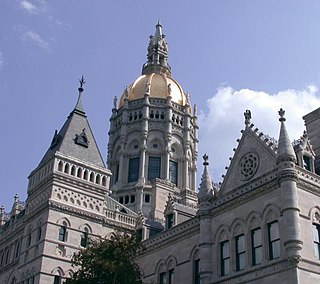
The neighborhoods of Hartford, Connecticut in the United States are varied and historic.

The Connecticut Governor's Residence serves as the official home of the Governor of Connecticut. It is located at 990 Prospect Avenue in Hartford.
Hillside Family of Agencies is one of the oldest family and youth non-profit human services organizations in Western and Central New York, USA. The agency started as Rochester Female Association for the Relief of Orphans and Destitute Children in 1837. The first year 46 children were served. The organization was renamed the Rochester Orphan Asylum in 1839, the organization constructed a larger facility in 1844 at Hubbell Park. In 1905 the group moved to the current Monroe Ave site. To reflect the shift from providing a home for orphans to caring for "dependent and neglected children," the Rochester Orphan Asylum changed its name in 1921 to Hillside Home for Children. Another name change came in 1940 when Hillside Children's Center was adopted and a goal set: "for every child, a fair chance for the development of a healthy personality".
During World War II Hillside Children's Center worked with Eastman Kodak to help the children of Kodak employees in England. Between 1940 and 1942, 156 British children were brought to the Rochester area by Kodak to safeguard them from the war in their home country. Hillside assisted in placing these "Kodakids," as they were called, with the families of local Kodak employees or in foster homes for the duration of the war.
In 1965, Hillside broadened its mission to helping "dependent, neglected, learning disabled, emotionally disturbed, socially maladjusted, and delinquent" children. During the 1970s, Hillside Children's Center experienced great growth. The institution began its conversion to a residential treatment center and reopened its campus school, which had been closed since 1931. In 1996 a new parent organization, Hillside Behavioral Health System (HBHS), was formed in order to provide services more efficiently and effectively. Hillside Children's Center and Hillside Children's Foundation served as partner affiliates. In 1996 the Wegmans Work Scholarship Connection joined Hillside to become Hillside Work Scholarship. In 1999, Hillside Behavioral Health System added to its family when Crestwood Children's Center and Crestwood Children's Foundation affiliated with it. Hillside Family of Agencies was adopted as the system name in December 2000 to better represent the diversity of services provided by each affiliate. In 2004 Hillside absorbed Snell Farms Children's Center and Adoption Resource Network, Inc.
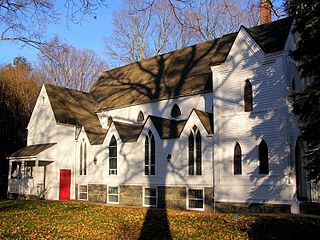
The Pine Meadow Historic District encompasses most of the historic 19th-century village of Pine Meadow in New Hartford, Connecticut. Located at a bend in the West Branch Farmington River southeast of New Hartford center, it is a well-preserved example of a rural industrial village. The district was listed on the National Register of Historic Places in 1996.

DePelchin Children's Center, founded in 1892 in Houston, Texas, is a nonprofit provider of children's mental health, prevention and early intervention, and child welfare services. DePelchin helps more than 20,000 children and their families each year through a range of services including counseling, psychiatry, residential treatment, at-risk programs, and parent education in addition to foster care and adoption. As one of the largest centers of its kind in Houston, DePelchin coordinates over thirty different programs for children and their families at schools, community sites, and in-home as well as at DePelchin's main Memorial campus and five satellite offices. The center continues to be recognized at the state and federal level for cutting-edge programs, including a federal grant as a leading child trauma expert in Texas.

The Prospect Avenue Historic District encompasses a predominantly residential area in western Hartford and eastern West Hartford, Connecticut. The 300-acre (120 ha) historic district extends along Prospect Avenue from Albany Avenue to Fern Street, including most of the area between those streets and the Park River to the east, and Sycamore Street and Sycamore Lane to the west. The district includes 240 contributing buildings and 48 non-contributing buildings, most of them residences built between 1880 and 1930. The district was listed on the National Register of Historic Places in 1985.

Carson College for Orphan Girls, also known as Carson Valley School, is a historic school complex and national historic district located in Flourtown, Springfield Township, Montgomery County, Pennsylvania. The buildings remain in active use by the same institution, now coeducational and named Carson Valley Children's Aid.

83-85 Sigourney Street in Hartford, Connecticut was an Italianate style double brick house. Built in 1865, it was the oldest surviving residential building on the southern part of Sigourney Street in the city's Asylum Hill neighborhood. It was listed on the National Register of Historic Places in 1979, at a time when there were no known threats to the building. A modern building, housing the former Connecticut Culinary Institute, now stands at 85 Sigourney Street; it is the Hartford campus of the Lincoln Culinary Institute, and is part of the Lincoln Group of Schools.

The Asylum Avenue District encompasses the institutional core of the Asylum Hill neighborhood of Hartford, Connecticut. Located just west of Downtown Hartford across Interstate 84, it includes four churches, a school, and a handful of adjacent 19th-century residences. It was listed on the National Register of Historic Places in 1979.
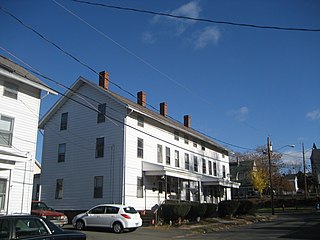
The Bigelow-Hartford Carpet Mills Historic District encompasses a company-built factory and residential area in the Thompsonville area of Enfield, Connecticut. In addition to the former factory buildings of the Bigelow-Hartford Carpet Mills, it includes more than 150 housing units built by the company between about 1830 and 1920. It is roughly bounded on the north by Lafayette Street and Alden Avenue, the east by Hartford Avenue and Lincoln Street, the south by High Street, and the west by River Street. It was listed on the National Register of Historic Places in 1994.

The Hartford Golf Club Historic District encompasses a golf course and adjacent residential neighborhood in West Hartford and Hartford, Connecticut. The area, developed between 1915 and 1936, includes the Hartford Golf Club, designed by Donald Ross, the area's oldest golf course, and a neighborhood with a high concentration of high quality Colonial and Tudor Revival houses. It is roughly bounded by Simsbury Road on the north, Bloomfield Avenue on the east, Albany Avenu to the south, and Mohegan Drive to the west. The district was listed on the National Register of Historic Places in 1986.

The Curtisville Historic District encompasses a predominantly residential area along Naubuc Avenue and Pratt Streets in northwestern Glastonbury, Connecticut. Developed mainly in the 19th century, it illustrates the coexistence of agricultural and industrial pursuits in a single village area, mixing worker housing, former farm properties, and a small mill complex. The district was listed on the National Register of Historic Places in 1992.

140 and 144 Retreat Avenue is a historic conjoined pair of houses in Hartford, Connecticut. Built in 1844 and 1851, the two houses are the only surviving reminders of the street's 19th-century streetscape. They were listed on the National Register of Historic Places in 1982.

The Jefferson-Seymour District is a historic district encompassing a residential area on the south side of Hartford, Connecticut. Covering portions of Cedar, Wadsworth, Seymour and Jefferson Streets, it contains a well-preserved collection of late 19th and early 20th-century middle-class residential architecture, primarily executed in brick. It was listed on the National Register of Historic Places in 1979.

The North-West School is a historic school building at 1240 Albany Avenue in Hartford, Connecticut. Built in 1891, it is a well-preserved example of a late 19th-century school building, considered state of the art at the time of its construction. It served the city as a school until 1978, and now stands vacant. It was listed on the National Register of Historic Places in 2010.
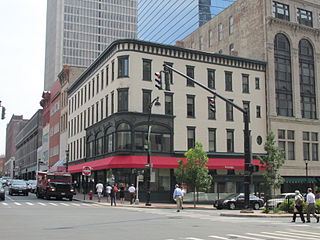
The Stackpole, Moore, and Tryon Building is a historic commercial building at 105-115 Asylum Street in downtown Hartford, Connecticut. Built in the mid-19th century, and extensively altered in 1896, it is a good local example of a period building with a Beaux Arts cast-iron facade. It was listed on the National Register of Historic Places in 1978.
